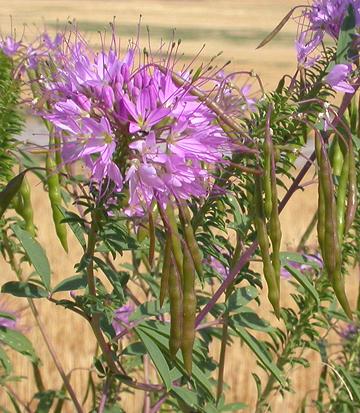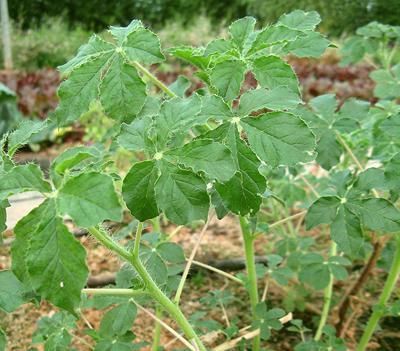 [Rocky Mountain beeplant, Beeweed, Stinking-clover, Bee Spider-flower,
Skunk weed; Cleome serrulata]
[Rocky Mountain beeplant, Beeweed, Stinking-clover, Bee Spider-flower,
Skunk weed; Cleome serrulata]
Native to the U.S. Southwest, this is one of a very few wild plants still significantly used for food in North America. The Zuni people in particular cook young shoots, leaves and flowers as a vegetable, and hang leaves to dry for winter use. It's bitter taste is sometimes relieved by adding some iron or rust to the pot. Seeds can be eaten raw or cooked, and are dried and ground to make mush. The plant is also often planted among the usual "Three Sisters" (corn, squash and beans) to attract polinating bees to the garden.
This plant has a number of medicinal uses and is used to make
dyes for pottery, baskets and fabrics.
Photo by Matt Lavin distributed under license
Creative Commons
Attribution 2.0 Generic.
 [Spider Plant, Shona cabbage, African cabbage, Spiderwisp,
Cat's whiskers, Chinsaga, Stinkweed, Wild Spinach; Magagani, Mkabili,
Mkabilishemsi, Mwangani, Mgange (Swahili);
Kisii (Kenya); Munyevhe (Shona Bantu); Ulude (Zulu); Ombidi, Omboga
(Oshiwambo); Echadoi (Uganda); Chingasa (Luo); Feuilles caya, Mozambe
(French); Volatin, Masambey, Jasmin de rio (Spanish); Vaminta, Vayinta
(Telugu); Tilavan (Marathi); Dek, Shwetahudhude (Bengali); Phak Sian
(Thai); Cleome gynandra]
[Spider Plant, Shona cabbage, African cabbage, Spiderwisp,
Cat's whiskers, Chinsaga, Stinkweed, Wild Spinach; Magagani, Mkabili,
Mkabilishemsi, Mwangani, Mgange (Swahili);
Kisii (Kenya); Munyevhe (Shona Bantu); Ulude (Zulu); Ombidi, Omboga
(Oshiwambo); Echadoi (Uganda); Chingasa (Luo); Feuilles caya, Mozambe
(French); Volatin, Masambey, Jasmin de rio (Spanish); Vaminta, Vayinta
(Telugu); Tilavan (Marathi); Dek, Shwetahudhude (Bengali); Phak Sian
(Thai); Cleome gynandra]
Tis herbaceous plant is native to tropical Africa, but has been spread to tropical and sub-tropical regions elsewhere in the world. In the United States it is found from Texas to North Carolina and in New York state. It is used as a cooking green in East and Southern Africa, and also Thailand and India. The leaves have a somewhat bitter, often peppery flavor like Mustard Greens. Photo by Pau Pámies Grácia distributed under license Creative Commons Attribution-ShareAlike 4.0 International
Tthe seeds are sometimes used as a replacement for mustard seeds, and they can be pressed for cooking oil. This plant has a number of medicinal uses. a
More on the Brassicales Family.
 [Asian Spiderflower, Wild Mustard, Spiderplant; Cléome
visqueuse, cléome gluante (French). Musambe (Zimbabwi?);
Mgagani (Swahili); | Seeds: Jakhya (Urdu); Dog Mustard,
Wild Mustard; Cleome viscosa]
[Asian Spiderflower, Wild Mustard, Spiderplant; Cléome
visqueuse, cléome gluante (French). Musambe (Zimbabwi?);
Mgagani (Swahili); | Seeds: Jakhya (Urdu); Dog Mustard,
Wild Mustard; Cleome viscosa]
This herbaceous plant is native to most of Sub-Saharan Afica, but not Southern Africa. It is also found in tropical Asia and the tropical Americas. In the United States it has been reported from several states on the Atlantic seaboard and states on the Gulf of Mexico. The somewhat bitter leaves, which also have some sharpness like mustard leaves, are eaten fresh, dried or cooked.
The fruit pods are eaten pickled. The seeds, called Jakhya (Urdu) are used similarly to mustard seeds, mainly in the plain south of the Himalayan foothills. the seeds can be pressed for a cooking oil. The seeds are becoming popular in India as a low cost substitute for Cumin, and it's cultivation is being encouraged because it grows better on marginal land than conventional crops. this plant has a number of medicinal uses. Photo by H Brisse distributed under license Creative Commons Attribution 3.0 Unported.
More on the Brassicales Family.